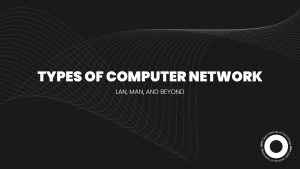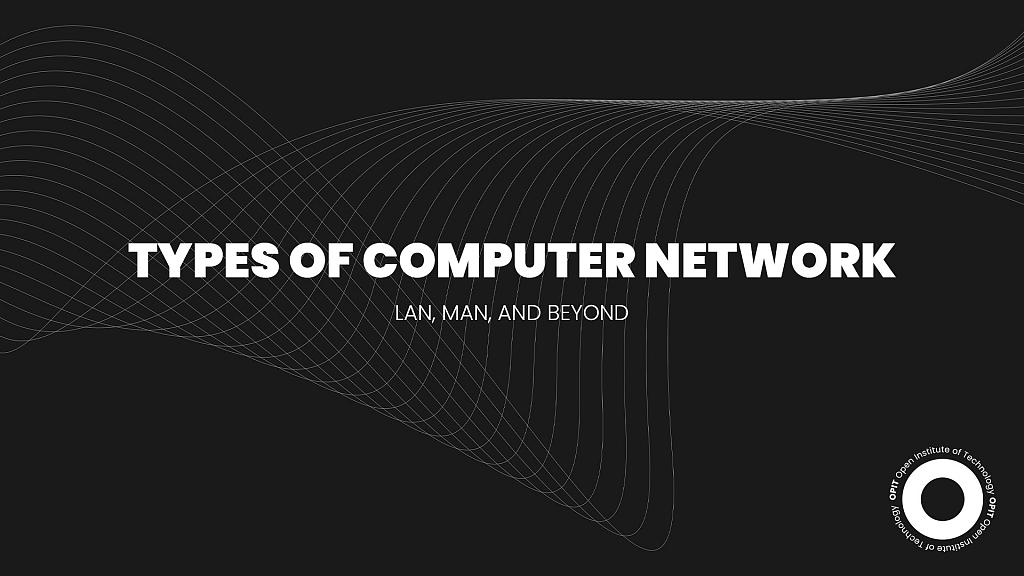

From the local network you’re probably using to read this article to the entirety of the internet, you’re surrounded by computer networks wherever you go.
A computer network connects at least two computer systems using a medium. Sharing the same connection protocols, the computers within such networks can communicate with each other and exchange data, resources, and applications.
In an increasingly technological world, several types of computer network have become the thread that binds modern society. They differ in size (geographic area or the number of computers), purpose, and connection modes (wired or wireless). But they all have one thing in common: they’ve fueled the communication revolution worldwide.
This article will explore the intricacies of these different network types, delving into their features, advantages, and disadvantages.
Local Area Network (LAN)
Local Area Network (LAN) is a widely used computer network type that covers the smallest geographical area (a few miles) among the three main types of computer network (LAN, MAN, and WAN).
A LAN usually relies on wired connections since they are faster than their wireless counterparts. With a LAN, you don’t have to worry about external regulatory oversight. A LAN is a privately owned network.
Looking into the infrastructure of a LAN, you’ll typically find several devices (switches, routers, adapters, etc.), many network cables (Ethernet, fiber optic, etc.), and specific internet protocols (Ethernet, TCP/IP, Wi-Fi, etc.).
As with all types of computer network, a LAN has its fair share of advantages and disadvantages.
Users who opt for a LAN usually do so due to the following reasons:
- Setting up and managing a LAN is easy.
- A LAN provides fast data and message transfer.
- Even inexpensive hardware (hard disks, DVD-ROMs, etc.) can share a LAN.
- A LAN is more secure and offers increased fault tolerance than a WAN.
- All LAN users can share a single internet connection.
As for the drawbacks, these are some of the more concerning ones:
- A LAN is highly limited in geographical coverage. (Any growth requires costly infrastructure upgrades.)
- As more users connect to the network, it might get congested.
- A LAN doesn’t offer a high degree of privacy. (The admin can see the data files of each user.)
Regardless of these disadvantages, many people worldwide use a LAN. In computer networks, no other type is as prevalent. Look at virtually any home, office building, school, laboratory, hospital, and similar facilities, and you’ll probably spot a LAN.
Wide Area Network (WAN)
Do you want to experience a Wide Area Network (WAN) firsthand? Since you’re reading this article, you’ve already done so. That’s right. The internet is one of the biggest WANs in the world.
So, it goes without saying that a WAN is a computer network that spans a large geographical area. Of course, the internet is an outstanding example; most WANs are confined within the borders of a country or even limited to an enterprise.
Considering that a WAN needs to cover a considerable distance, it isn’t surprising it relies on connections like satellite links to transmit the data. Other components of a WAN include standard network devices (routers, modems, etc.) and network protocols (TCP/IP, MPLS, etc.).
The ability of a WAN to cover a large geographical area is one of its most significant advantages. But it’s certainly not the only one.
- A WAN offers remote access to shared software and other resources.
- Numerous users and applications can use a WAN simultaneously.
- A WAN facilitates easy communication between computers within the same network.
- With WAN, all data is centralized (no need to purchase separate backup servers, emails, etc.).
Of course, as with other types of computer network, there are some disadvantages to note.
- Setting up and maintaining a WAN is costly and challenging.
- Due to the higher distance, there can be some issues with the slower data transfer and delays.
- The use of multiple technologies can create security issues for the network. (A firewall, antivirus software, and other preventative security measures are a must.)
By now, you probably won’t be surprised that the most common uses of a WAN are dictated by its impressive size.
You’ll typically find WANs connecting multiple LANs, branches of the same institution (government, business, finance, education, etc.), and the residents of a city or a country (public networks, mobile broadband, fiber internet services, etc.).
Metropolitan Area Network (MAN)
A Metropolitan Area Network (MAN) interconnects different LANs to cover a larger geographical area (usually a town or a city). To put this into perspective, a MAN covers more than a LAN but less than a WAN.
A MAN offers high-speed connectivity and mainly relies on optical fibers. “Moderate” is the word that best describes a MAN’s data transfer rate and propagation delay.
You’ll need standard network devices like routers and switches to establish this network. As for transmission media, a MAN primarily relies on fiber optic cables and microwave links. The last component to consider is network protocols, which are also pretty standard (TCP/IP, Ethernet, etc.)
There are several reasons why internet users opt for a MAN in computer networks:
- A MAN can be used as an Internet Service Provider (ISP).
- Through a MAN, you can gain greater access to WANs.
- A dual connectivity bus allows simultaneous data transfer both ways.
Unfortunately, this network type isn’t without its flaws.
- A MAN can be expensive to set up and maintain. (For instance, it requires numerous cables.)
- The more users use a MAN, the more congestion and performance issues can ensue.
- Ensuring cybersecurity on this network is no easy task.
Despite these disadvantages, many government agencies fully trust MANs to connect to the citizens and private industries. The same goes for public services like high-speed DSL lines and cable TV networks within a city.
Personal Area Network (PAN)
The name of this network type will probably hint at how this network operates right away. In other words, a Personal Area Network (PAN) is a computer network centered around a single person. As such, it typically connects a person’s personal devices (computer, mobile phone, tablet, etc.) to the internet or a digital network.
With such focused use, geographical limits shouldn’t be surprising. A PAN covers only about 33 feet of area. To expand the reach of this low-range network, users employ wireless technologies (Wi-Fi, Bluetooth, etc.)
With these network connections and the personal devices that use the network out of the way, the only remaining components of a PAN are the network protocols it uses (TCP/IP, Bluetooth, etc.).
Users create these handy networks primarily due to their convenience. Easy setup, straightforward communications, no wires or cables … what’s not to like? Throw energy efficiency into the mix, and you’ll understand the appeal of PANs.
Of course, something as quick and easy as a PAN doesn’t go hand in hand with large-scale data transfers. Considering the limited coverage area and bandwidth, you can bid farewell to high-speed communication and handling large amounts of data.
Then again, look at the most common uses of PANs, and you’ll see that these are hardly needed. PANs come in handy for connecting personal devices, establishing an offline network at home, and connecting devices (cameras, locks, speakers, etc.) within a smart home setup.
Wireless Local Area Network (WLAN)
You’ll notice only one letter difference between WLAN and LAN. This means that this network operates similarly to a LAN, but the “W” indicates that it does so wirelessly. It extends the LAN’s reach, making a Wireless Local Area Network (WLAN) ideal for users who hate dealing with cables yet want a speedy and reliable network.
A WLAN owes its seamless operation to network connections like radio frequency and Wi-Fi. Other components that you should know about include network devices (wireless routers, access points, etc.) and network protocols (TCP/IP, Wi-Fi, etc.).
Flexible. Reliable. Robust. Mobile. Simple. Those are just some adjectives that accurately describe WLANs and make them such an appealing network type.
Of course, there are also a few disadvantages to note, especially when comparing WLANs to LANs.
WLANs offer less capacity, security, and quality than their wired counterparts. They’re also more expensive to install and vulnerable to various interferences (physical objects obstructing the signal, other WLAN networks, electronic devices, etc.).
Like LANs, you will likely see WLANs in households, office buildings, schools, and similar locations.
Virtual Private Network (VPN)
If you’re an avid internet user, you’ve probably encountered this scenario: you want to use public Wi-Fi but fear the consequences and stream specific content. Or this one may be familiar: you want to use apps, but they’re unavailable in your country. The solution for both cases is a VPN.
A Virtual Private Network, or VPN for short, uses tunneling protocols to create a private network over a less secure public network. You’ll probably have to pay to access a premium virtual connection, but this investment is well worth it.
A VPN provider typically offers servers worldwide, each a valuable component of a VPN. Besides the encrypted tunneling protocols, some VPNs use the internet itself to establish a private connection. As for network protocols, you’ll mostly see TCP/IP, SSL, and similar types.
The importance of security and privacy on the internet can’t be understated. So, a VPN’s ability to offer you these is undoubtedly its biggest advantage. Users are also fond of VPNs for unlocking geo-blocked content and eliminating pesky targeted ads.
Following in the footsteps of other types of computer network, a VPN also has a few notable flaws. Not all devices will support this network. Even when they do, privacy and security aren’t 100% guaranteed. Just think of how fast new cybersecurity threats emerge, and you’ll understand why.
Of course, these downsides don’t prevent numerous users from reaching for VPNs to secure remote access to the internet or gain access to apps hosted on proprietary networks. Users also use these networks to bypass censorship in their country or browse the internet anonymously.
Connecting Beyond Boundaries
Whether running a global corporation or wanting to connect your smartphone to the internet, there’s a perfect network among the above-mentioned types of computer network. Understanding the unique features of each network and their specific advantages and disadvantages will help you make the right choice and enjoy seamless connections wherever you are. Compare the facts from this guide to your specific needs, and you’ll pick the perfect network every time.
Related posts

Source:
- Times of Malta, published on September 18th, 2025
4 min read
The gathering brought together academics and technology leaders from prominent European Institutions, such as Instituto de Empresa (IE University), OPIT itself and the Royal College of Arts, to explore how artificial intelligence is reshaping the university experience.
The OPIT AI Copilot has been trained on the institute’s complete academic archive, a collection created over the past three years that includes 131 courses, more than 3,500 hours of recorded lectures, 7,500 study resources, 320 certified assessments, and thousands of exercises and original learning documents.
Unlike generic AI tools, the Copilot is deeply integrated with OPIT’s learning management system, allowing it to track each student’s progress and provide tailored support.
This integration means the assistant can reference relevant sources within the learning environment, adapt to the student’s stage of study, and ensure that unreleased course content remains inaccessible.
A mobile app is also scheduled for release this autumn, that will allow students to download exercise and access other tools.
During examinations, the Copilot automatically switches to what the institute calls an “anti-cheating mode”, restricting itself to general research support rather than providing direct answers.
For OPIT’s international community of 500 students from nearly 100 countries, many of whom balance studies with full-time work, the ability to access personalised assistance at any time of day is a key advantage.
“Eighty-five per cent of students are already using large language models in some way to study,” said OPIT founder and director Riccardo Ocleppo. “We wanted to go further by creating a solution tailored to our own community, reflecting the real experiences of remote learners and working professionals.”
Tool aims to cut correction time by 30%
The Copilot will also reduce administrative burdens for faculty. It can help grade assignments, generate new educational materials, and create rubrics that allow teachers to cut correction time by as much as 30 per cent.
According to OPIT, this will free up staff to dedicate more time to teaching and direct student engagement.
At the Milan event, Rector Francesco Profumo underlined the broader implications of AI in higher education. “We are in the midst of a deep transformation, where AI is no longer just a tool: it is an environment that radically changes how we learn, teach, and create,” he said.
“But it is not a shortcut. It is a cultural, ethical, and pedagogical challenge, and to meet it we must have the courage to rethink traditional models and build bridges between human and artificial intelligence.”
OPIT was joined on stage by representatives from other leading institutions, including Danielle Barrios O’Neill of the Royal College of Art, who spoke about the role of AI in art and creativity, and Francisco Machin of IE University, who discussed applications in business and management education.
OPIT student Asya Mantovani, also employed at a leading technology and consulting firm in Italy, gave a first-hand account of balancing professional life with online study.
The assistant has been in development for the past eight months, involving a team of OPIT professors, researchers, and engineers.
Ocleppo stressed that OPIT intends to make its AI innovations available beyond its own institution. “We want to put technology at the service of higher education,” he said.
“Our goal is to develop solutions not only for our own students, but also to share with global institutions eager to innovate the learning experience in a future that is approaching very quickly.”

From personalization to productivity: AI at the heart of the educational experience.
Click this link to read and download the e-book.
At its core, teaching is a simple endeavour. The experienced and learned pass on their knowledge and wisdom to new generations. Nothing has changed in that regard. What has changed is how new technologies emerge to facilitate that passing on of knowledge. The printing press, computers, the internet – all have transformed how educators teach and how students learn.
Artificial intelligence (AI) is the next game-changer in the educational space.
Specifically, AI agents have emerged as tools that utilize all of AI’s core strengths, such as data gathering and analysis, pattern identification, and information condensing. Those strengths have been refined, first into simple chatbots capable of providing answers, and now into agents capable of adapting how they learn and adjusting to the environment in which they’re placed. This adaptability, in particular, makes AI agents vital in the educational realm.
The reasons why are simple. AI agents can collect, analyse, and condense massive amounts of educational material across multiple subject areas. More importantly, they can deliver that information to students while observing how the students engage with the material presented. Those observations open the door for tweaks. An AI agent learns alongside their student. Only, the agent’s learning focuses on how it can adapt its delivery to account for a student’s strengths, weaknesses, interests, and existing knowledge.
Think of an AI agent like having a tutor – one who eschews set lesson plans in favour of an adaptive approach designed and tweaked constantly for each specific student.
In this eBook, the Open Institute of Technology (OPIT) will take you on a journey through the world of AI agents as they pertain to education. You will learn what these agents are, how they work, and what they’re capable of achieving in the educational sector. We also explore best practices and key approaches, focusing on how educators can use AI agents to the benefit of their students. Finally, we will discuss other AI tools that both complement and enhance an AI agent’s capabilities, ensuring you deliver the best possible educational experience to your students.
Have questions?
Visit our FAQ page or get in touch with us!
Write us at +39 335 576 0263
Get in touch at hello@opit.com
Talk to one of our Study Advisors
We are international
We can speak in:
